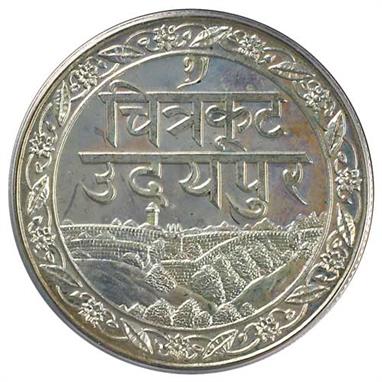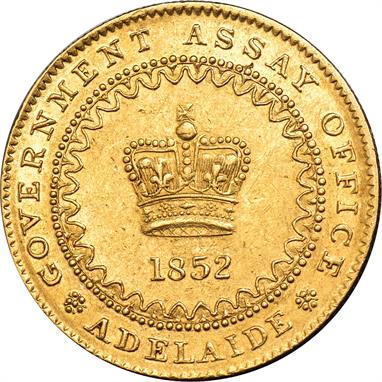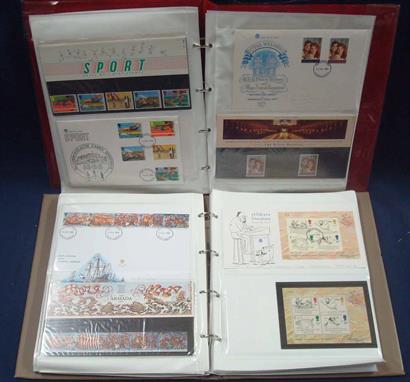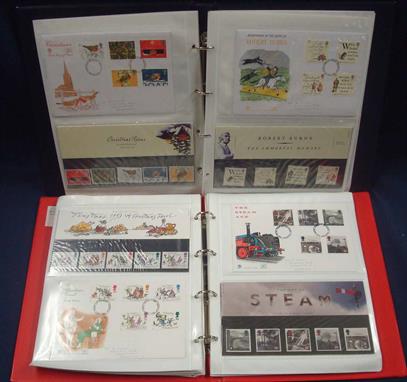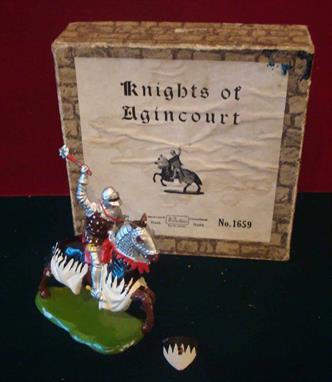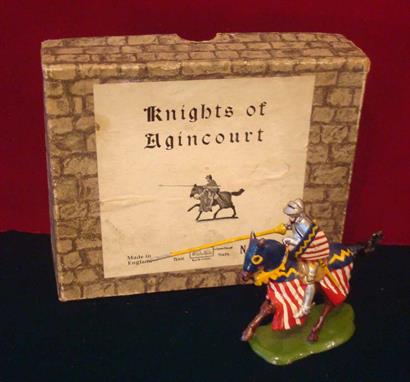We found 596772 price guide item(s) matching your search
There are 596772 lots that match your search criteria. Subscribe now to get instant access to the full price guide service.
Click here to subscribe- List
- Grid
-
596772 item(s)/page
A.C.H. BRANNAM POTTERY FISH SPOUT MOTTO JUG Decorated with incised four line motto to one side and a fish the other, incised and dated 1898. Artist`s initials `S.W.` to base; together with another blue gournd floral decorated jug, incised `C.H. Brannam Barum` and dated 1888 to base The first 14cm high (2)
TWO C.H.BRANNAM POTTERY VASES BY FREDERICK BOWDEN The first with three handles, decorated with fish on a green/blue ground, incised `C.H. Brannam Barum` dated 1897 and signed with initials `FB`; the second with two handles, motto and fish decoration, incised `C.H. Brannam Barum 1895, FB` to base The first 16cm high
TEN ORDNANCE SURVEY 1:50,000 FIRST SERIES SHEET MAPS comprising sheets 181 (Minehead & Brendon Hills); 182 (Weston-super-Mare & Bridgwater); 183 (Yeovil & Frome); 184 (Salisbury & The Plain); 185 (Winchester & Basingstoke); 192 (Exeter & Sidmouth); 193 (Taunton & Lyme Regis); 194 (Dorchester & Weymouth); and 195 (Bournemouth & Purbeck).
[ASSORTED]. CRICKET & OTHER Tinkler, Basil. A Somerset Hero Who Beat the Aussies. The Life and Times of J.C. `Farmer` White, first edition, The Parrs Wood Press, Manchester, 2000, boards, dustjacket, illustrations, octavo; Arlott, John. Days at the Cricket, first edition, Longmans, Green & Co., London, 1951, boards, dustjacket, illustrations, octavo; and others, (six boxes).
[CRICKET]. Foot, David. A History of Somerset Cricket. Sunshine, Sixes and Cider, first edition, David & Charles, Newton Abbot, 1986, boards, dustjacket, octavo; with Somerset County Cricket Handbooks, 1980-86 inclusive; Somerset County Cricket Club Yearbooks, 1988-92 inclusive; and a small quantity of other publications of related interest.
GIANDOMENICO BELOTTI (1922-1998) & ALIAS (Éditeur) Paire de chaises "Spaghetti", dessin de 1979, à structure en acier tubulaire laqué rose reposant sur des patins de caoutchouc noir, dossier incliné et assise tendus d’un tissage de PVC rose. Étiquette d’éditeur. A pair of "Spaghetti" steel and plastic-cord chairs, designed in 1979. Producer’s label. Haut. 64,5 cm - Larg. 32,5 cm - Prof. 36 cm / Height. 25 3⁄8 in.- Width. 12 3⁄4 in. - Depth. 14 1⁄8 in. Historique : Symbole de l’histoire du design, ce modèle spaghetti est le premier modèle réalisé par Alias à avoir été présent dans les collections du MoMA de New York. A symbol in the history of design, spaghetti is the first Alias chair to appear in the MoMA collection of New York. Bibliographie : Thomas Müller, Romana Schneider, "Das Klassenzimmer. Schulmöbel im 20. Jahrhundert", Éditions Prestel, 1998, p. 143.
Peter MURDOCH (Né en 1940) &PAPER INTERNATIONAL (Éditeur) Chaise "Spotty", 1963, en papier cartonné enduit de polyéthylène, à décor de grands pois bleus sur fond blanc, à découpe supérieure par pliure pour former assise. Cachet de l’artiste. (Quelques usures). A rare printed cardboard "Spotty" chair, 1963. Producer’s stamp. (A few wears). Haut. 51 cm - Larg. 50 cm - Prof. 43 cm Height. 20 1⁄8 in. - Width. 19 3⁄4 in. - Depth. 16 7⁄8 in. Historique : Ce modèle n’a été réalisé qu’entre 1964 et 1965. Première chaise à être entièrement réalisée en papier cartonné, elle répondait aux attentes d’un marché de consommation plus attaché à l’effet de nouveauté qu’à la durabilité. Ce modèle est de ce fait devenu très rare. This model was created between 1964 and 1965. It’s the first chair fully made with only paperboard. It was a respond to the consumer expectations more linked to the novelty rather than durability. This model become, for this reason, very rare to find. Bibliographie : - Charlotte & Peter Fiell, "1 000 chairs", Éditions Taschen, Cologne, 1997, p. 465. - Carole Daprey, "Mobilier Design pour enfants", Piqpoq, 2009, Paris, p. 108.
Walter PAPST (1924-2008) & WILKHAHN (Éditeur) Cheval à bascule, 1958, en polyester renforcé de fibre de verre, teintée rouge, structure de forme libre stylisée découpée. Poignées tubulaires en ABS blanc. (Quelques petits éclats). A fiberglass reinforced polyester rocker, 1958. (A few small chips). Haut. 53 cm - Larg. 43 cm - Long. 81 cm Height. 20 7⁄8 in. - Width. 16 7⁄8 in. - Length. 31 7⁄8 in. Historique : Walter Papst est parmi les premiers designers en Europe à avoir utilisé le polyester renforcé de fibre de verre. Walter Papst is among the first designers in Europe to have used the fiberglass. Bibliographie : - Eva B Ottillinger, "Fidgety Philip" : A Design History of Children’s Furniture", Vienne, 2006, p. 159. - Carole Daprey, "Mobilier Design pour enfants", Piqpoq, 2009, Paris, p. 103.
GIORGIO DECURSO & JONATHAN DE PAS (1932-1991) & DONATO D’URBINO (Né en 1935) & PAOLO LOMAZZI (Né EN 1936) - BBB BONACINA (Éditeur) Suite de douze chaises Junior démontables et empilables, "4 Knock Down”, dessin de 1972, en ABS rouge ou jaune, dont les piétements cylindriques ou les dossiers peuvent s’imbriquer indifféremment les uns dans les autres, permettant ainsi de créer des géométries ludiques et variables tel qu’un paravent. Cachet d’éditeur. A set of twelve "4 Knock Down" red or yellow plastic chairs, that can be dismantled and build large objects such as screen, designed in 1972. Haut. 50 cm - Larg. 30 cm - Prof. 32,5 cm Height. 19 3⁄4 in. - Width. 11 3⁄4 in.- Depth. 12 3⁄4 in. Bibliographie : - Emilio Ambasz, "Italy : New Domestic Landscape", Museum of Modern Art ; First edition, New York, 1972. - Thomas Müller, Romana Schneider, "Das Klassenzimmer. Schulmöbel im 20. Jahrhundert", Éditions Prestel, 1998, p. 145. - Carole Daprey, "Mobilier Design pour enfants", Piqpoq, 2009, Paris, pp. 130-131.
†Oliver Cromwell, broad, 1656, by Thomas Simon, laur. bust l., rev. crowned shield of arms (S.3225; N.2744), in plastic holder, graded by PCGS as Mint State 62, a handsome example with a most pleasing golden red tone, nearly as struck with deeply frosted portrait and shield, light handling in the fields, finer than many seen, rare and appealing as the first milled gold coin equivalent in value in its day to the early guinea, which would appear within a few years of this historic coinage
†Charles II, crown, 1666, XVIII, elephant below, second laur. bust r., rev. crowned cruciform shields, interlinked Cs in angles, variety reading RE.X (S.3356; ESC.34), some weakness on the high points, otherwise almost extremely fine *ex Bridgewater House, lot 345 The scarcer of the two varieties of this date, this is certainly one of the finest known, with an impeccable pedigree from the Bridgewater House collection. The first time to appear in a London saleroom for many years.
†George III, pattern crown, 1817, by W. Wyon, the ‘Incorrupta Crown’, laur. head r., date below, W. WYON below truncation, rev. crowned shield of arms, edge plain (ESC.229 [R4]; L&S.159), in plastic holder, graded by NGC as Proof 65, beautifully toned, extremely rare *ex Willis II, Glendining’s, October 1991, lot 465 ex Ariagno, Goldbergs, June 1999 lot 1838 (back cover picture) ex Kardatzke III, Goldbergs, June 2000, lot 4663 (front cover picture) ex St James’s Auction 1, October 2004, lot 520 Only 18 silver and 7 gold proof examples struck. This is one of the two 1817 pattern crowns designed and engraved by a young William Wyon as entries in a competition for the production of a new crown coinage for Great Britain to begin in 1818. This would be the first crown coinage struck by the new Tower Hill Mint’s steam presses which began striking other coins in 1816. As all students and collectors of British coinage know, William Wyon went on to a very successful career as the chief engraver for the British Empire, but at this point in his life, having recently gained an assistantship at the Mint under his cousin, Chief Engraver Thomas Wyon, William was in a competitive battle with a foreigner, Italian gem engraver Benedetto Pistrucci, whose beautiful engravings had caught the eye of Sir Joseph Banks, an influential friend of the Master of the Mint. After Thomas Wyon’s death in 1817, Banks determined to make Pistrucci his successor as chief engraver but ran into problems as the law prohibited a foreigner from holding the position. Since the government had decided to produce a new Crown coinage in 1818, both men, Wyon and Pistrucci, were tasked with producing samples for the new coinage. As is well known, Pistrucci ultimately won that competition with his design of St. George and the dragon which appeared on the new crown series of 1818-1820.However, William Wyon’s design entries, the Incorrupta crown in this lot, as well as the 1817 Three Graces Pattern, show clearly the talents for design and engraving that would shortly put an end to Pistrucci’s coinage ambitions, catapult William to fame during the reigns of George IV and, most importantly, Queen Victoria, and establish him forever as one of the pre-eminent engravers in the history of coinage. The popular name of this crown, ‘Incorrupta’, derives from the reverse legend, in Latin, which translates as ‘An Untarnished Faith’, or roughly ‘A Faith that is Beyond Corruption’ or incorruptible. A superb example of this famous rarity with its masterful bust of George III, it exhibits lovely bluish purplish toning acquired over centuries, and its fields and devices show very few distractions and no wear. NGC has graded it PF65, equivalent to gem proof in the American system, FDC in the British. It is the finest graded at NGC and tied for finest at PCGS, the two main US grading services. Its rarity and outstanding condition for a 200-year old coin combine to make this a prize for the advanced collector of British crowns. That this coin’s prior ownership traces to a set of very discriminating collectors also attests to its desirability as does its appearance on the back and front covers of two previous auctions. When bidding on this coin, remember that it is almost impossible to find early 19th century proof coins in such a state of preservation given the sensitivity of proof surfaces and the lack of concern about handling and surface marks that characterized the habits of past generations of collectors.
†Victoria, pattern crown, 1837, by or for Joseph Bonomi (an Egyptologist), incuse Egyptian-style design showing queen’s head l. with tight bun hairstyle, rev. Britannia walking r., with trident and shield, holding Victory, incuse inscription to l. and r., border of stars each side, numbered 1 on edge (ESC.320; L&S.1), in plastic holder, graded by NGC as Proof 62, about as struck This is a highly important piece as it was the first example struck, denoted by the number on the edge.
India, Princely States, Mewar, proof set of rupee, ½ rupee, ¼ rupee, 1⁄8 rupee, and 1⁄16 rupee, VS.1985 (1928), landscape, legend above, rev. legend and date (cf KM.Y22/Y21/Y20/Y19/Y18 - not listed in proof), in plastic holders, graded by PCGS, the first four as Proof 63, the last as Proof 65, very rare (5) A superb brilliant proof set.
NOT AVAILABLE FOR ONLINE BIDDING. PLEASE CONTACT THE AUCTIONEER IF YOU WANT TO BID ON THIS LOT.USA, Panama-Pacific Exposition, 1915, commemorative set in gold and silver: gold octagonal 50 dollars, gold round 50 dollars, gold 2½ dollars, gold dollar, and silver 50 cents, all struck at the San Francisco mint, the rare complete set in original case with certificate of issue, extremely fine or better with some light hairlines, the two 50 dollars lightly wiped, rich gold toning on the gold coins, the silver 50 cents having lovely silvery gold surfaces with rich blue peripheral toning (5) The concept of a ‘world’s fair’ showcasing human achievement was an idea essentially of the 19th century, even though exhibitions were an age-old phenomenon. In America, the Centennial Exhibition of 1876 held in Fairmount Park in Philadelphia was intended both to show off new technical achievements and to celebrate a century of independence as a nation. The Paris Exhibition of 1889 followed. The World’s Columbian Exhibition of 1892-93 in Chicago was an even grander affair, where a small city was erected consisting of buildings, canals and parks; its ostensible purpose was to mark the 400th anniversary of the discovery of the New World. Not to be outdone, Paris again hosted an exhibition in 1900, and St Louis in Missouri felt a need to express itself and hosted a fair in 1904, where the summer Olympic Games were only part of all the excitement. Its formal name was The Louisiana Purchase Exposition but its purpose was largely as a commercial enterprise to attract tourists who wished to purchase gifts of many kinds for themselves as mementoes, and to be entertained. The west coast of the United States, however, was a long-distance trip not only for Europeans arriving by ship on the east coast but also for much of the American population. Californians were clamouring for their own world’s fair by the turn of the century. Beginning in 1904, a variety of plans and schemes for a festival was being considered in San Francisco, and the goal was to outdo other American exhibitions. The terrible earthquake disrupted plans only temporarily, and by 1911 the organizing council had the approval of none other than President Taft, who embraced the idea of a West Coast fair celebrating both American ingenuity and the opening of the Panama Canal in 1911, which was being hailed as a new wonder of the world. What is today known as the Marina District was filled with land while engineers constructed a variety of buildings meant to be temporary. Included in the plans for this mini city was even a 5-acre reproduction of the Panama Canal! After 3 years of construction, the Panama-Pacific International Exposition opened on 20 February 1915, occupying 635 acres by the bay. Featuring a vast array of landscape architecture, statuesque buildings, ornate gardens, art of many kinds, clever inventions, countless displays of wares and products, sports and entertainment — the fair showed the throngs of visitors what the world looked like in 1915. Perhaps the most spectacular event of the fair was the first-ever use of electricity to light up the entire city at night. Although coins commemorating such fairs had been issued before, at this exposition an entire set of specially designed coins was produced for sale to fair-goers. They could purchase single coins or, rarely, an entire set, as we see in the presently offered lot. Due to the high value of the set, at a time when the average yearly income was about $1500, few sets were purchased. Thus was born a modern rarity, in which the individual coins featured designs intended to commemorate the opening of the Panama Canal expressed in Art Deco style. All of the coins were struck at the fair. The half-dollar features the symbolic Miss Liberty scattering flowers which she received from a cornucopia, with the rising sun behind her, an expression of bounty and optimism. The gold dollar depicts a capped labourer, among many who built the Panama Canal. Its reverse features a pair of dolphins, symbolizing the flowing together of two oceans via the canal. The gold 2½ dollars, or ‘quarter eagle’, reputedly shows Columbia seated upon a hippocampus with a vigilant eagle on the other side said in its day to be warding off war. The huge, impressive gold 50 dollar coins, similarly designed but of different shapes, were supposedly meant to pay obeisance to the fifty-dollar ‘pioneer gold’ coins of the 1849ers. Each featured a helmeted Greek goddess Athena as a symbol of wisdom and of warfare, as well as of the practical arts, opposed by a large owl alluding to the inspiration of antiquity. It is seated upon a branch surrounded by Ponderosa pinecones, native to California. Dolphins ‘swim’ around the rim of the Octagonal, emblematic sailors’ guardians seen in the open seas on each side of the canal. Each coin also boasts a proud legend of the nation and another indicating its origin at the Exposition. It took massive hydraulic presses to produce these beautiful coins. They are among the finest of all numismatic expressions of the Art Deco era.
24 ASSORTED SINGLE MALT MINIATURES Assorted Single Malt Miniature bottles, all 5cl, including: Talisker 100° Proof; Glenturret 10 (57.1% volume); Glendullan 12 (47% volume); Glendullan 12 (82.3° Proof); Glenturret 8 (75° Proof); Glenturret 15 (43% volume); Duncan Taylor Glenrothes 35 (40.3% volume); 2 x Arran First Production 1995 (63.5% volume); Talisker 8 (45.8& volume); Port Ellen Signatory Vintage 1979 (43% volume); Aberlour 100° Proof; Auchentoshan 10 (40% volume); 2 x Glenkinchie 10 (43% volume); The Glendronach 70° Proof; Glenrothes 1992 (43% volume, 100ml); Whisky Castle 100; Auchentoshan 10 (43% volume); Glenrothes 12 (43% volume); Tomintoul 17 (40% volume); Aberlour 9 (70° Proof); Balblair (40% volume). 24 Miniatures Good.
NOT AVAILABLE FOR ONLINE BIDDING. PLEASE CONTACT THE AUCTIONEER IF YOU WANT TO BID ON THIS LOT.G George V, sovereign, 1920S, bare head l., rev. St. George and the dragon, S raised on ground-line above date, horse with long tail (S.4003; McD.264; KM.29; Fr.38; Marsh 280), some light surface marks, virtually as struck, mint mark bold, with famous die combination featuring a pickled or rusted reverse die *ex Jacob Garrard, April 1920. Thence by descent to daughter / granddaughter ex Noble Numismatics Sydney, Australia, Sale 50, 20-22 March 1996, lot 1470 Private treaty into ‘George’ collection by Monetarium Australia Pty Ltd. This is a legendary offering which includes recently discovered information that may help to solve the ‘enigma’ partially explained in the Bentley sale catalogue’s description of that collection’s 1920 Sydney sovereign. In that sale, the coin was called the rarest of all issues of the sovereign series, rarer even than the famed 1819 sovereign struck at London, of which some 10-12 examples exist compared to perhaps 4-5 (one impounded in the Royal Australian Mint Collection) of the 1920 Sydney issue. Of the 4 pieces for which sales have been traced, apparently the finest known, called a Specimen in the Quartermaster Collection sale of 2009, seems to have been struck at a later date (1926) from a reverse die that was cleared of the residue which protected it during the long sea voyage from England to Australia. This residue accounts for the ‘pickled’ or slightly rough appearance of the reverse, a characteristic of all other known examples. The normal satiny gold texture exists on the obverse of all. The Bentley sale cataloguer concluded by suggesting that this coin’s great rarity did not arise from any melting of the reported mintage at Sydney for the year (which he believed represented coins dated 1919 but struck in January and June 1920 at Sydney) but instead that no pieces were struck during 1920 bearing the date and S mint mark except because of some ‘special event’ in the year which was unknown at the time of the Bentley sale. The provenance of the presently offered coin dates precisely to April 1920 and may well explain that ‘special event’ and the coin’s great rarity. Researcher Barrie Winsor of Australia has identified the family who placed a special order for sovereigns dated 1920 at the Sydney Mint in 1920. A prominent New South Wales politician and trade unionist. Mr Jacob Garrard (Note 1) ordered and purchased the sovereigns from the Mint in order to present them to his children when he and his wife, Rebecca, celebrated their golden wedding anniversary on 15 April 1920. Barrie Winsor has interviewed some of the Garrard descendants to confirm the facts and has also seen photographs of the family taken during the anniversary meetings (see below). Five sons and two daughters were the subjects of the gifts; the exact number of sovereigns minted for the Garrards remains unknown, nor is it known if each of the sons and daughters received a coin (both daughters but only two sons survived Jacob Garrard when he passed away on 5 November 1931). The mintage presumably could not have been more than 7 sovereigns, or 9 if one each was retained by the parents. Aside from the wretched condition of the reverse dies received after the long sea voyage, which apparently caused Mint officials to decide against their use, why were fresh dies not ordered? Why is the coin so rare? The answer appears to be that the post-WWI metals market fluctuations rendered coinage of gold impractical. The report of the Royal Mint issued on 31 December 1920 notes that the quoted value of gold per troy ounce as of 5 February 1920 was 127s 4d per ounce (Note 2). This meant that the cost of minting a single gold sovereign with a face value of 20 shillings was over 30 shillings. The Royal Mint suspended minting sovereigns in 1917 until 1925 and the Canadian Mint ceased production of sovereigns in 1919. Clearly the Sydney Mint decided to postpone gold coinage. In 1920, transmission of any such decision was incomplete when Jacob Garrard placed his special order, thereby unknowingly creating the greatest gold rarity of the British Empire. There are only 3 other known examples of the 1920S sovereign sold on the open market: The first, sold by Spink and Son (Australia) Pty Ltd, 2 November 1978, lot 631, nearly extremely fine, ex A H F Baldwin collection, realised AU$3,600 hammer price Then sold by Spink and Son, London, 15 March 1992, lot 438, good extremely fine, realised £104,000 hammer price The second, a specimen or proof striking sold in the Quartermaster collection, Monetarium (Australia) Pty Ltd, 4 June 2009, lot 196, FDC, realised AU$800,000 hammer price. This coin has been struck from a good reverse die as opposed to the other four which all appear to be from a rusty reverse die. The third, ex Jaggards, Sydney Australia, retail list, February 1979 Then sold by Kurt Jaggard Monetary Auctions, Australia, 11 April 2006, lot 404, realised AU$582,500, purchased by Winsor and Sons, Jamberoo, NSW Australia Then sold in the Bentley Collection, Baldwins, 27 September 2012, lot 736, practically as struck, realised £650,000 hammer price. Note 1 See biography - Jacob Garrard (1846-1931) - Australian Dictionary of Biography. http://adb.anu.edu.au/biography/garrard-jacob-3595. Note 2 See Royal Mint Report 31 Dec 1920. Appendix No IX. - A. Messrs. Mocatta and Goldsmid’s Circular on the movement of Gold and Silver during 1920. page 72.
NOT AVAILABLE FOR ONLINE BIDDING. PLEASE CONTACT THE AUCTIONEER IF YOU WANT TO BID ON THIS LOT.G Australia, Victoria, Adelaide, pound, type one, fine edge milling, crowned date within beaded circle, dentillated pattern within the beading, legend surrounds the design declaring the issuer as the GOVERNMENT ASSAY OFFICE with a floral stop on each side of ADELAIDE at centre bottom, rev. VALUE ONE POUND within a surrounding pattern similar to that of the obverse, weight and purity declaration occupying the surrounding legend space, die cracked at top of legend (KM.1; Fr.1; McD. Type I), extremely fine for this issue, with frosty lustre The first gold rush in Australia took place near the town of Adelaide, with the usual effects of a discovery of great mineral wealth: at first the town was nearly abandoned by the rush to the gold fields, followed by an influx of unrefined ore which could not be easily exchanged for either official money or goods. Coinage bearing the monarch’s effigy and authority could not be quickly implemented, nor would royal sanction be a certainty, so the local authorities — the banking manager and the colonial treasurer — had little choice but to authorize a substitute money, technically a token struck in gold. If pure and good, it would be widely accepted alongside British coinage circulating in Australia. An act of coinage passed by the South Australian Legislative Council caused the creation of a Government Assay Office almost immediately upon passage of the Bullion Act, but its gold ingots were not practical nor assured of exact value. Towards the end of the year 1852, in November, the first ‘pounds’ were struck from fresh dies. Unfortunately, the reverse die failed almost immediately, cracking finely at the top of the legend from the inner beading to the rim to left of DWT. A new die of slight variation was quickly prepared and was used to strike almost all Adelaide gold pounds known today. By February of 1853, a scant four months after the experiment of minting at Adelaide had begun, the last of the Adelaide pounds had been struck — some 25,000 in all, almost the entire mintage being of the second dies combination. Most have perished, as is true of almost all kinds of ‘territorial’ gold coinages: first subjected to the abuses of ordinary commerce, damaged or fashioned into jewellery, and finally turned in for their gold content (for they were in fact finer than the standard sovereign) to be made into new coins. These first, tentative attempts at desperately needed money in Southern Australia have become much coveted by collectors worldwide. The Type One issue, of which it is believed that no more than 50 were minted, is both a great rarity and the very first gold coin struck in Australia. The appearance at auction of any specimen is a landmark event, but here we see one of the finest known examples of this great Australian rarity.
WWII Deutschland Erwacht German Book: The real first edition (not mentioning any later printing on title page) with the chapter "Hitler und seine SA" still mentioning Röhm as "Chef des Stabes der SA". In later printings this chapter has been rewritten completely. The portrait of Röhm has been changed for that of his successor Victor Lutze, but the new caption has been pasted on the old one, as likewise on several occasions elsewhere in the work where SA-leaders are concerned. The caption on p. 114 mentions a.o. Victor Lutze, whereas in later printings this has been changed in "Victor Lutze, der jetzige Chef des Stabes". With the large portrait of Hitler as frontispice and the enormous (130 x 30, 5cm) 6-times folding panoramic view of the "Standartenweihe in Luitpoldhain 1933". Binding designed by Felix Albrecht. Unfortunately wanting the dust-jacket, but complete with all the b/w and coloured pictures. Text by Wilfrid Bade. Ed. photographs: Heinrich Hoffmann. Edges original binding with minor shelf-wear. Very good copy. Excellent condition. An astonishing piece of propaganda.(some damage to spine but still retaining Dust Jacket Together with a copy Adolf Hitler Picture Album (having water damage) (2)
Deactivated Erma Luger 7.65mm Pistol: In fair deactivated condition. This neat little `Luger` first appeared in 1969 and was marketed by Erma as the KGP 68. They are obviously small calibre copies of the PO8 and are actually made to a very high standard of fit and finish. They seem to be popular both in Europe and the USA and are reliable little plinking guns. It is deactivated in the United Kingdom having Birmingham proof marks and a certificate stating that the weapon has been deactivated correctly and is legal within the U.K
Signed Sporting First Day Covers: To consist of 2 US covers signed by Robin Cousins, 8x Bob Hope British Golf Classic all having 1981 Charles and Diana Stamps signed by Michael Crawford, Dickie Davies, Mike Yardwood, Nevis Hughes, Telly Salvelsas 12 in total together with 6 Open Championship FDC Sandy Lyle
-
596772 item(s)/page




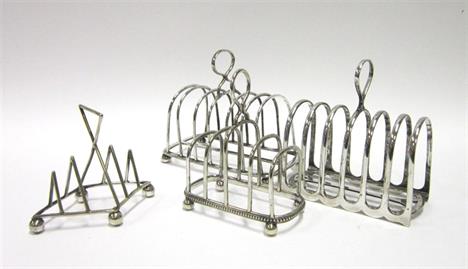
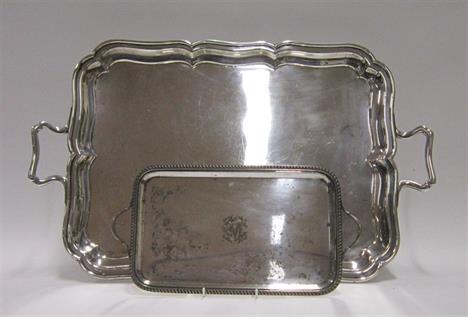





![[ASSORTED]. CRICKET & OTHER Tinkler, Basil. A Somerset Hero Who Beat the Aussies. The Life and Times of J.C. `Farmer` Wh](http://lot-images.atgmedia.com/SR/10066/2902790/251-2014228104817_468x382.jpg)
![[CRICKET]. Foot, David. A History of Somerset Cricket. Sunshine, Sixes and Cider, first edition, David & Charles, Newton](http://lot-images.atgmedia.com/SR/10066/2902790/255-2014228104827_468x382.jpg)









